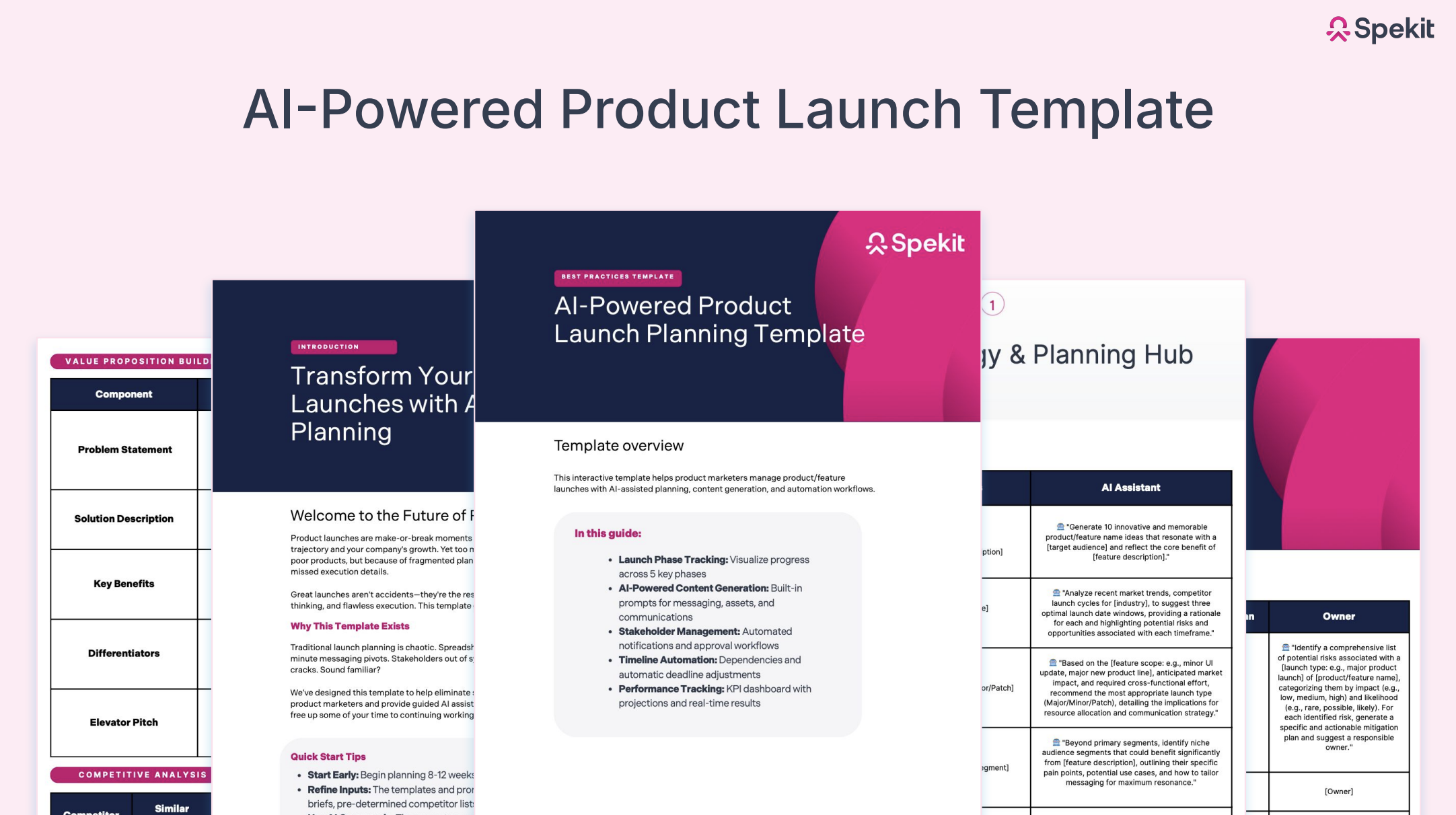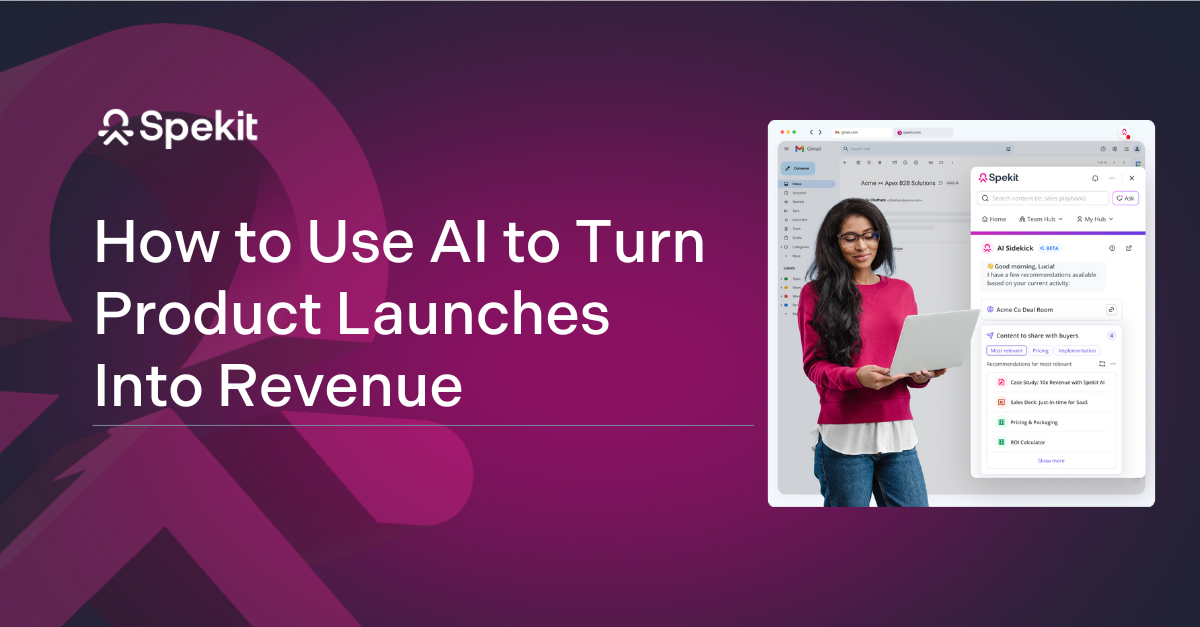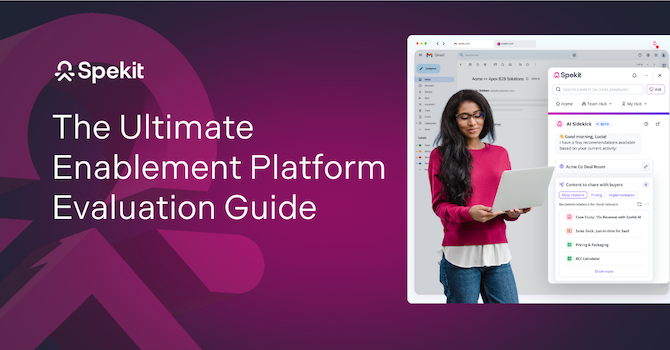This post is based on our latest webinar, “How to Build a Better Product Launch Plan (with a Little Help from AI),” featuring Melanie Fellay and Jeanna Roggow from Spekit. It reflects both our launch enablement playbook and how we use AI internally to turn launch day into actual revenue.

TLDR;
- Launch day isn't then end—it's what starts the enablement race. AI closes the gap from ship to sell.
- Clarify owners, run a biweekly launch council, and keep one source of truth.
- Tier the external announcement separately from the enablement effort by behavior change.
- Start from a product brief. Use AI to generate messaging, assets, and release notes.
- Build one playlist that powers learning and selling, and serve guidance in the flow of work.
- Measure leading indicators while revenue lags, then iterate weekly.
Quick Answers
What is just-in-time enablement?
Guidance delivered at the exact moment of need, inside the tools where work happens, so teams act faster with fewer clicks and without context switching.
Why use AI for product launches?
Because AI converts one brief into a complete launch kit. It drafts messaging, builds assets, accelerates training, and powers real-time content and messaging recommendations that compress time to adoption and time to revenue.
What changes for go-to-market teams?
They shift from one-and-done training to a daily reinforcement loop with clear roles, reusable playlists, and AI that helps inside email, CRM, and deal rooms.
How do you measure success early?
Track internal adoption signals and buyer engagement before win rate moves. Use those signals to coach and to tune content while the quarter is still live.
The Big Idea: Collapse “Launch” and “Monetize”
Every launch has two curves. Curve one is build, test, ship. Curve two is enable, adopt, monetize. The distance between those curves is where deals stall. You close that gap with AI-assisted, just-in-time enablement that meets reps in the flow of work. Not another portal. Not a bigger deck. A system of action that shows up when a seller is writing the email, updating the record, or sharing a plan with a buyer.
Launch day is a starting gun, not a graduation. Your job is to make the right move the easy move, right when someone needs it.
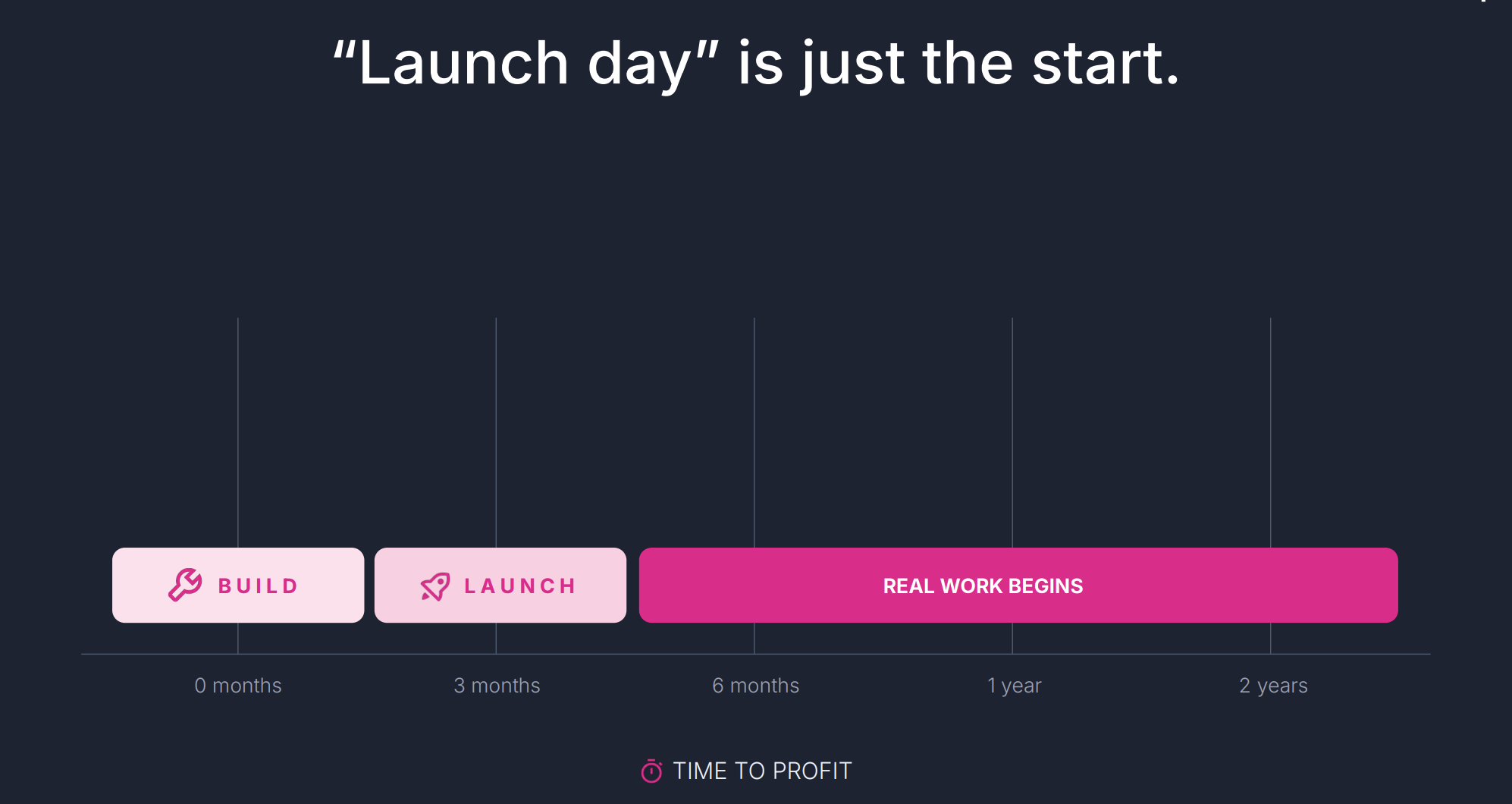
Why Now
Two truths you can feel:
- Velocity is up. Attention is down. Teams ship weekly, and no one gets extra hours. Every touch has to carry more weight.
- Pressure is compounding. Competition is tighter while quotas are tougher to hit: 57% of reps say competition has gotten harder, 67% don’t expect to hit quota this year, and 84% missed last year (Salesforce 2024 State of Sales Report).
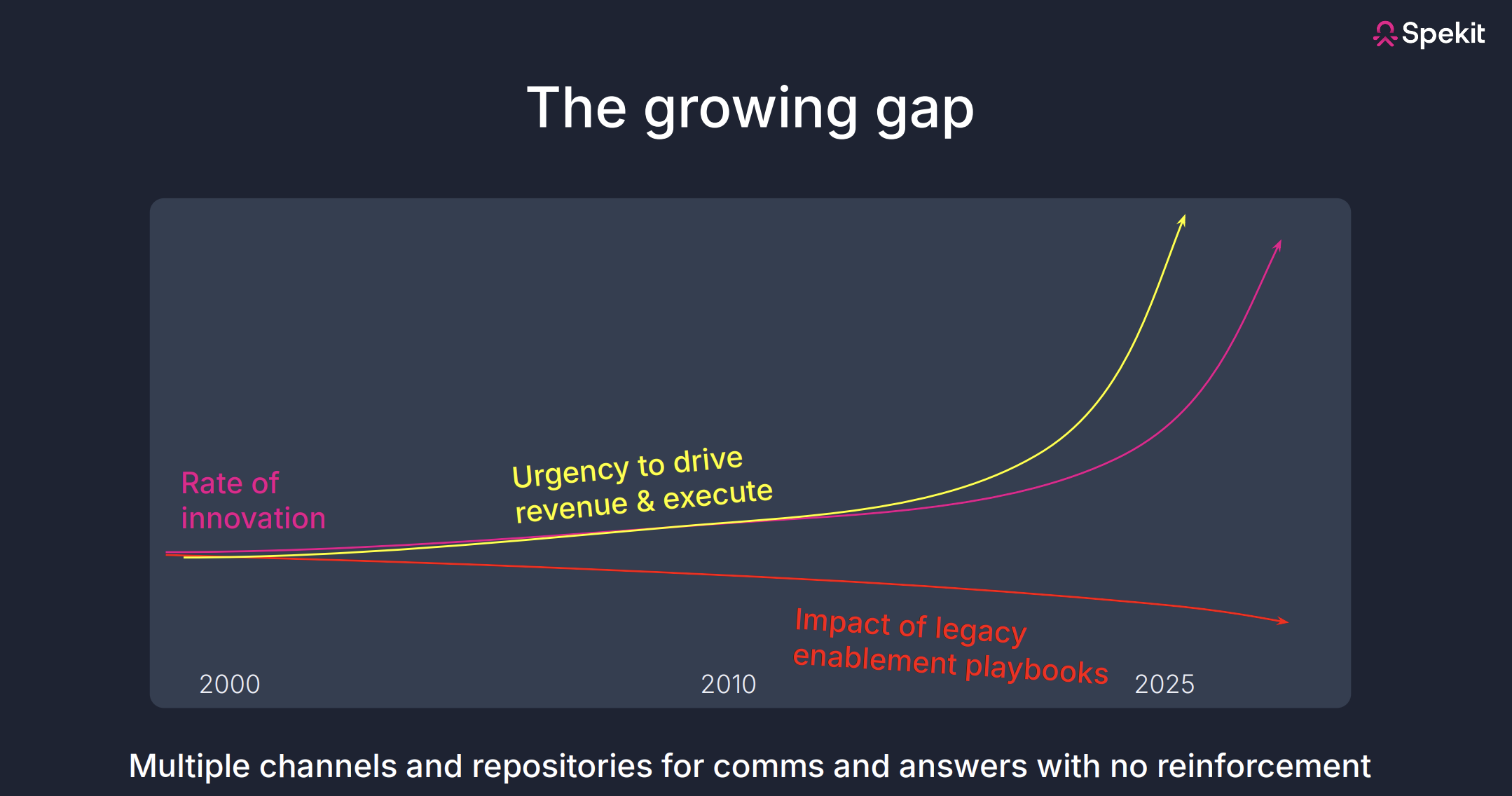
And the way most companies manage change hasn’t kept up. We still bias for change management over change enablement, a 95/5 split that can’t keep pace with weekly product velocity.
Add the handoff tax: 54% of teams lack functional handoffs between marketing and sales, which is exactly how launches turn reactive and momentum dies.
So we trade ceremony for rhythm. Less one-time training. More in-flow coaching. More small moments done right.
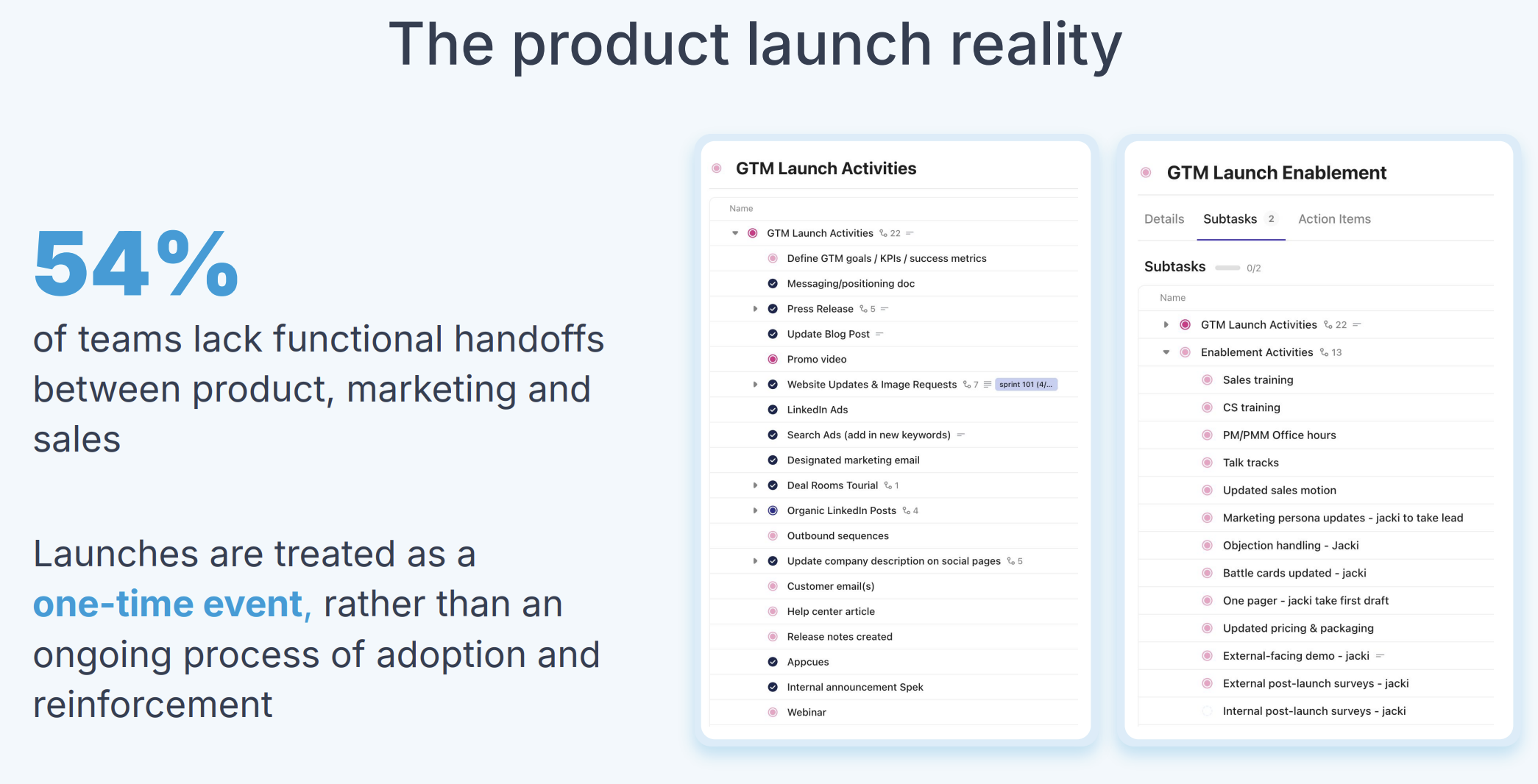
The Playbook: 10 Moves to Turn Product Launches Into Revenue
Play 1: Name the Owners. Then Meet on a Drumbeat.
Ambiguity kills speed. Before assets or training, assign ownership across Product, PMM, Enablement, RevOps, and Support. Then set a biweekly launch council with a clear agenda and a single pre-read. The goal is simple: no surprises, faster handoffs. (At Spekit, we run large, cross-functional biweekly launch reviews between R&D leadership, CS, Enablement, PMM, and exec sponsors because that’s what it takes to keep pace).
Copy this
- Biweekly meeting with three sections: Product status, GTM readiness, Enablement & Ops.
- One owner posts decisions, owners, and links to assets after each meeting.
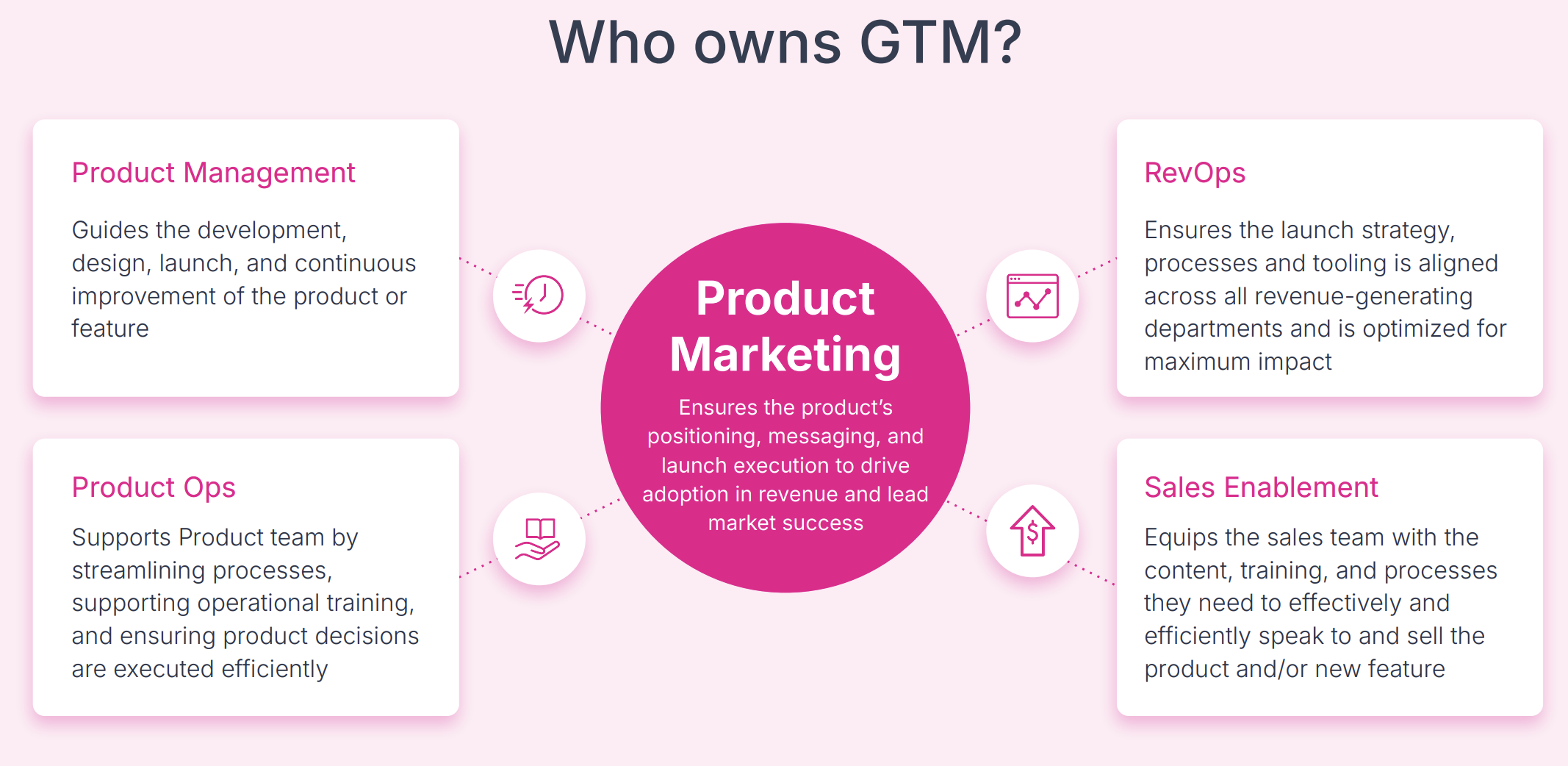
Play 2: Tier the Launch. Separate External Motion from Enablement Effort.
Not every release needs a campaign. Some do. Score external impact on a simple four-tier scale so you map effort to expected attention. Then size enablement separately by behavior change. A small, low-buzz feature can require deep training if it changes a core workflow. A big brand moment can need light enablement if little changes for reps. (At Spekit, we explicitly decouple external tiers from enablement tiers after learning they pull in different directions).
Copy this
- Publish both tiers in the kickoff doc. External tier drives marketing effort. Enablement size drives training, reinforcement, and measurement.
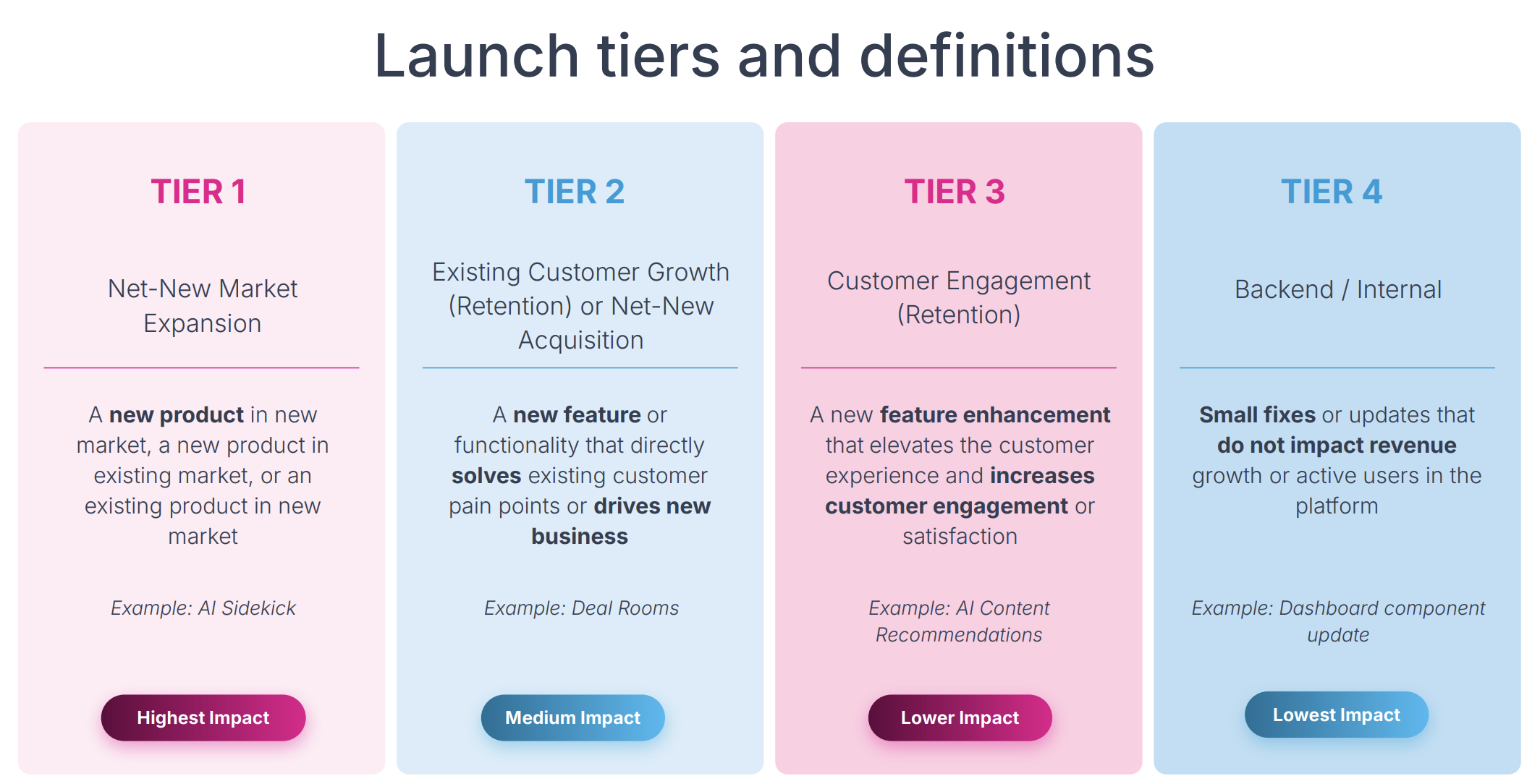
Play 3: Map Out the Swim Lanes With RACI.
If everyone owns it, no one does. A basic RACI prevents the crunch-time scramble and sets a default for reassignments when timelines compress. It also teaches new teammates how you ship.
Copy this
- Add RACI to the kickoff and link it from every meeting note and task tracker.
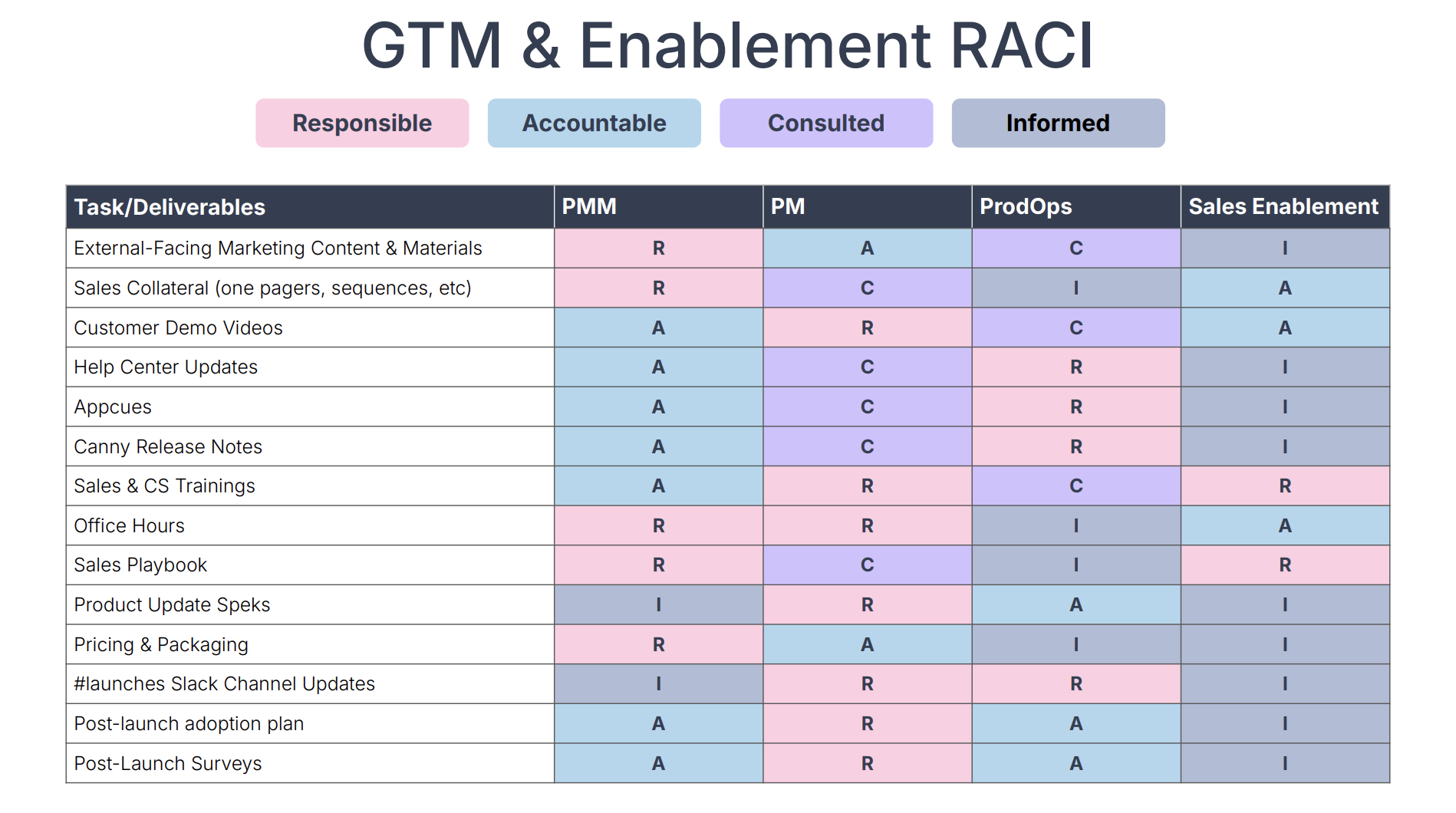
Play 4: Share a Timeline Both R&D and Marketing Can Trust.
Move from fuzzy target dates to milestone gates. Example gates: messaging draft complete, demo cut recorded, playlist ready, approvals set in your assistive layer, help article live. When engineering finishes early, use AI to compress the content side without dropping quality. (At Spekit, we generally aim for one or two Tier-1 releases per quarter; timelines flex with build speed, which is exactly why you need shared gates.)
Copy this
- Set a “no-surprise Tier-1” rule. Big launches need runway unless upstream velocity changes.
🎥 Want the full product launch webinar? Watch Melanie and Jeanna break down how to turn a single product brief into training, messaging, and just-in-time guidance and how Spekit uses AI to power each step. 👉 Watch the webinar here.
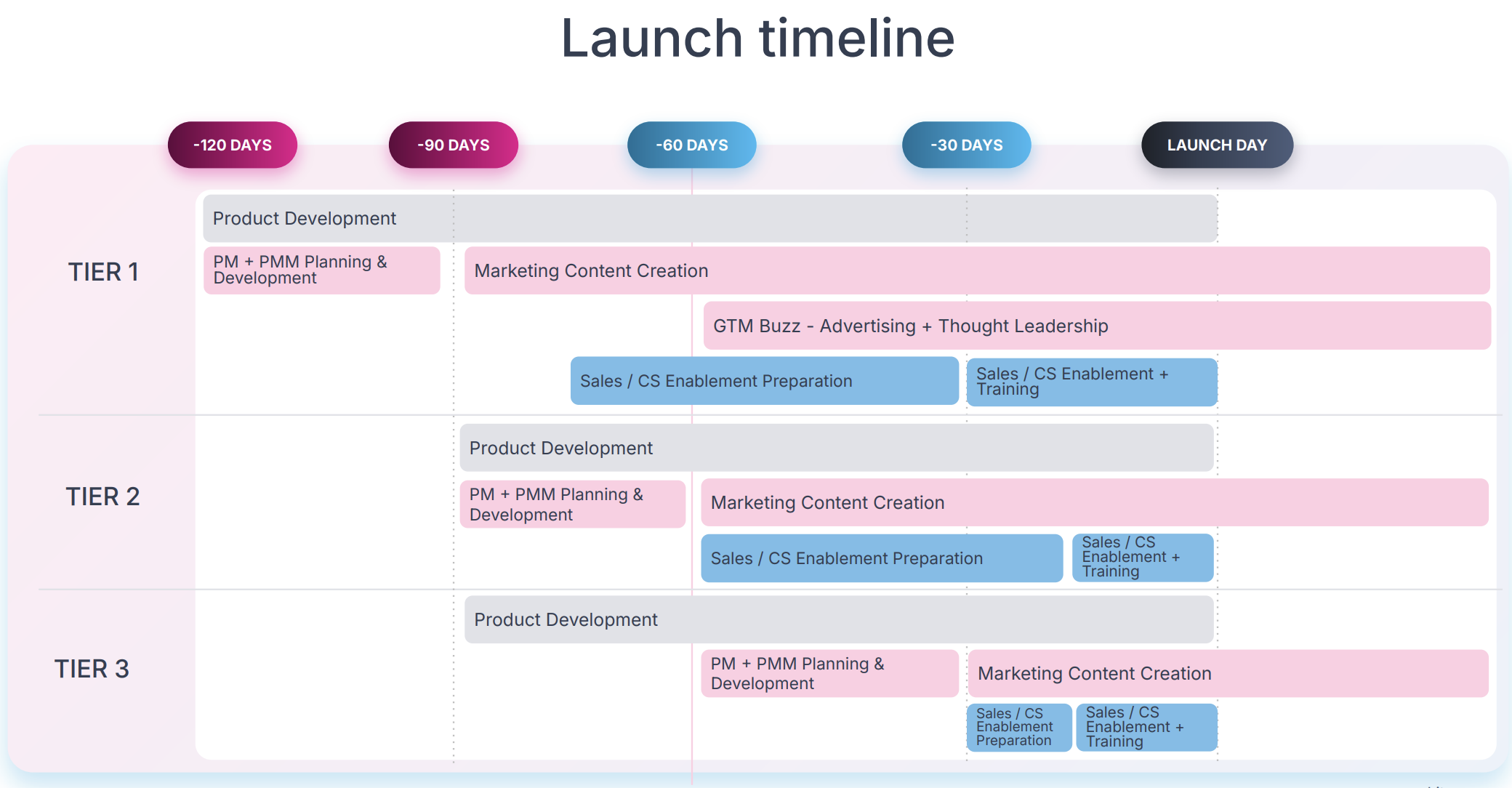
Play 5: Start With a Product Brief. Use AI to Propagate Messaging.
The brief is the nucleus. It explains why, scope, beta vs GA, what is in and out, and how success is measured. PMM drops the brief into a trained messaging template to get to 80% fast. That single source then feeds talk tracks, the feature page, help center notes, release notes, and the deck. (The Spekit team uses the brief + Jira tickets to auto-generate technical release notes for Support, no re-typing.)
Copy this
- No brief, no launch date. Use AI to draft messaging and release notes from the same input.
Play 6: Build Once. Reuse Everywhere With Playlists and Templates.
Templates are critical for saving time and driving process consistency. Keep templates for personas, objections, competitive notes, talk tracks, and messaging. For each launch, clone a playlist that powers both learning and selling. The deck a rep studies is the deck they clone for buyers. Then it drops into a deal room. (Spekit runs launch playlists with initiative overview, 3-minute demo, positioning, competitive, and a buyer-ready deck.)
Copy this
- Standard playlist sections: Overview, 3-minute demo, messaging one-pager, persona notes, objections, competitive, buyer deck.
Play 7: Communicate Without Noise. Weekly Updates and Targeted Nudges.
You don’t need five channels yelling at once. Use one weekly product update that links to a Product Updates hub. When needed, add a page-level spotlight in the app or CRM. Less spam. More signal. (The Spekit team uses email updates and in-app spotlights to call attention to the playlist, then points straight to the content instead of making people hunt).
Copy this
- Friday “what shipped” note with links to playlist and docs. Spotlight only for high-impact learning moments.
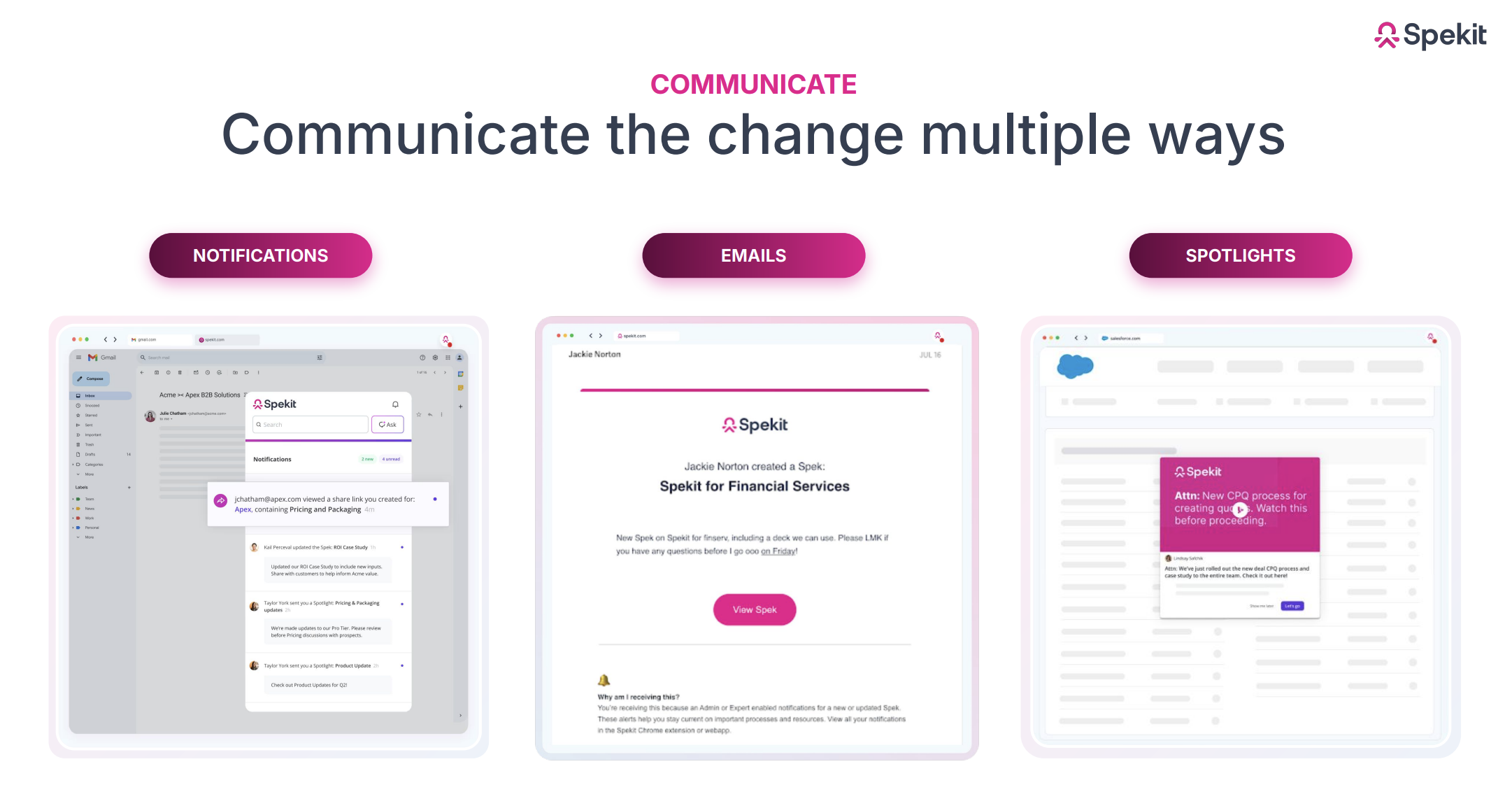
Play 8: Move From Push to Pull With AI-Powered Just-in-Time Recommendations.
This is the heart of just-in-time enablement. When a seller opens Salesforce or drafts an email, Spekit's AI Sidekick reads the context and suggests what to send and what to read. Competitive one-pager. Short feature video. The right security doc. It also shows internal share counts as social proof, so the right move becomes the easy move.
Copy this
- Sync your enablement and product marketing content and light it up where reps type with Spekit. One click to add the right asset to the buyer’s deal room.
Play 9: Plan Reinforcement Like Retargeting.
One live session is a moment. A system is what sticks. Layer reinforcement: a playlist for structure, small Knowledge Checks for recall, Spotlights to focus attention, and AI Sidekick recommendations at the edge. (Long, monolithic certifications consume time and decay fast; short recall checks a few days later are more effective).
Copy this
- Replace long certifications with two-minute checks two to five days later. Managers review one question in weekly one-on-ones.
Play 10: Measure Leading Indicators While Revenue Lags.
Revenue and win rate trail by weeks. You need earlier truth. Track whether the right teams completed the playlist, which assets are viewed and shared, if the updated deck shows up in deal rooms, and whether CRM fields reflect the new feature. Then correlate with conversion later. (There's a massive content usage gap, 86% believe reps use less than 60% of their content, so instrument internal views/shares and buyer engagement to see what actually sticks. PMMs also cite their top challenge as enabling reps to use the right content effectively).
Copy this
- Review leading indicators in the biweekly council. Tune messaging and assets while the quarter is still live.
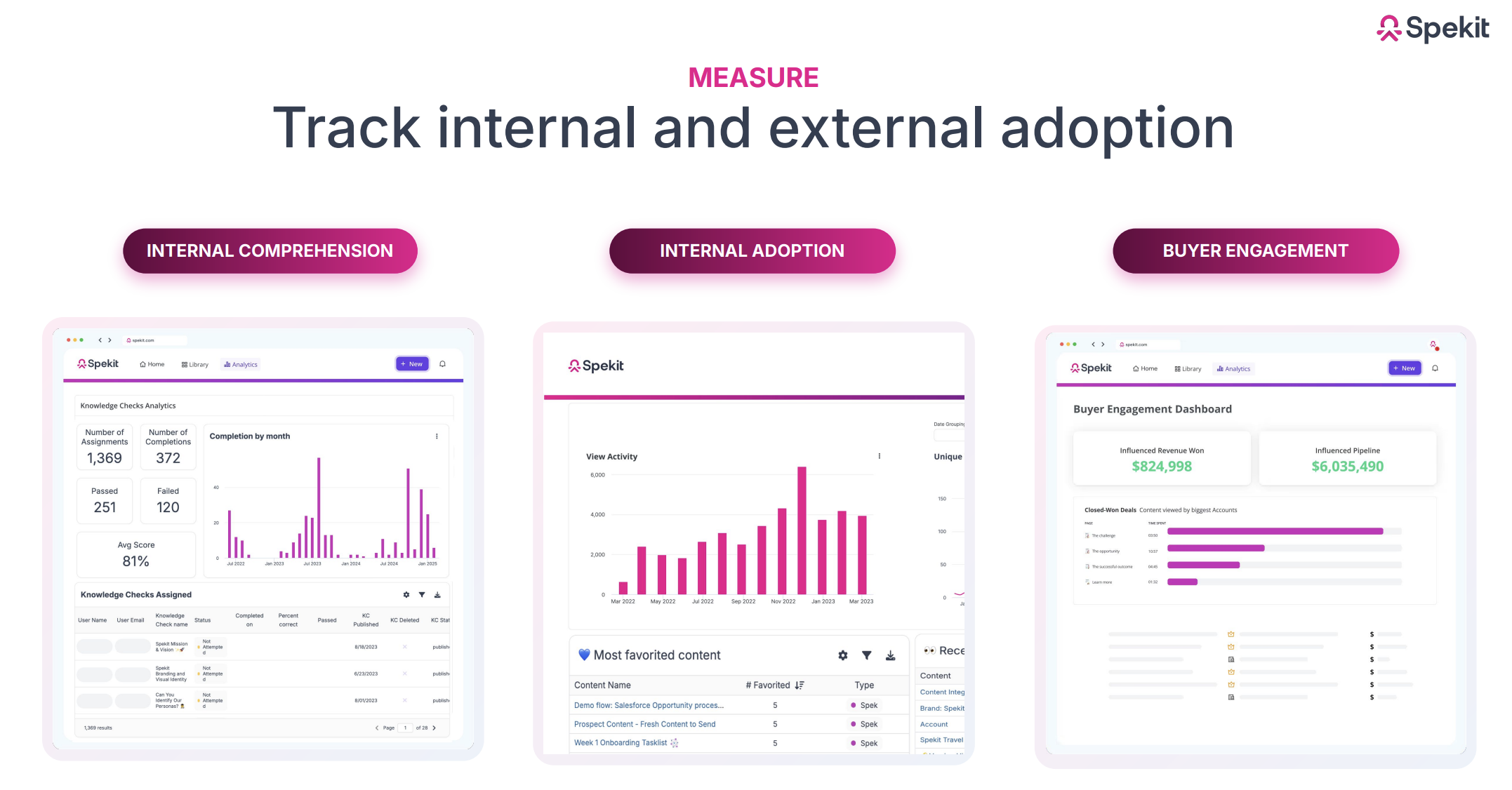
The Enablement Sizing Matrix
This is about behavior change. Size your enablement by how much work changes and whether the change is differentiated or expected.
- Extra-large change, differentiated: deep enablement. Workshops, new demo flows, repeated reinforcement.
- Large change, expected: deep enablement even if external marketing stays quiet.
- Medium change, differentiated: async learning plus just-in-time help.
- Small change, expected: FYI with in-flow support. No ceremony.
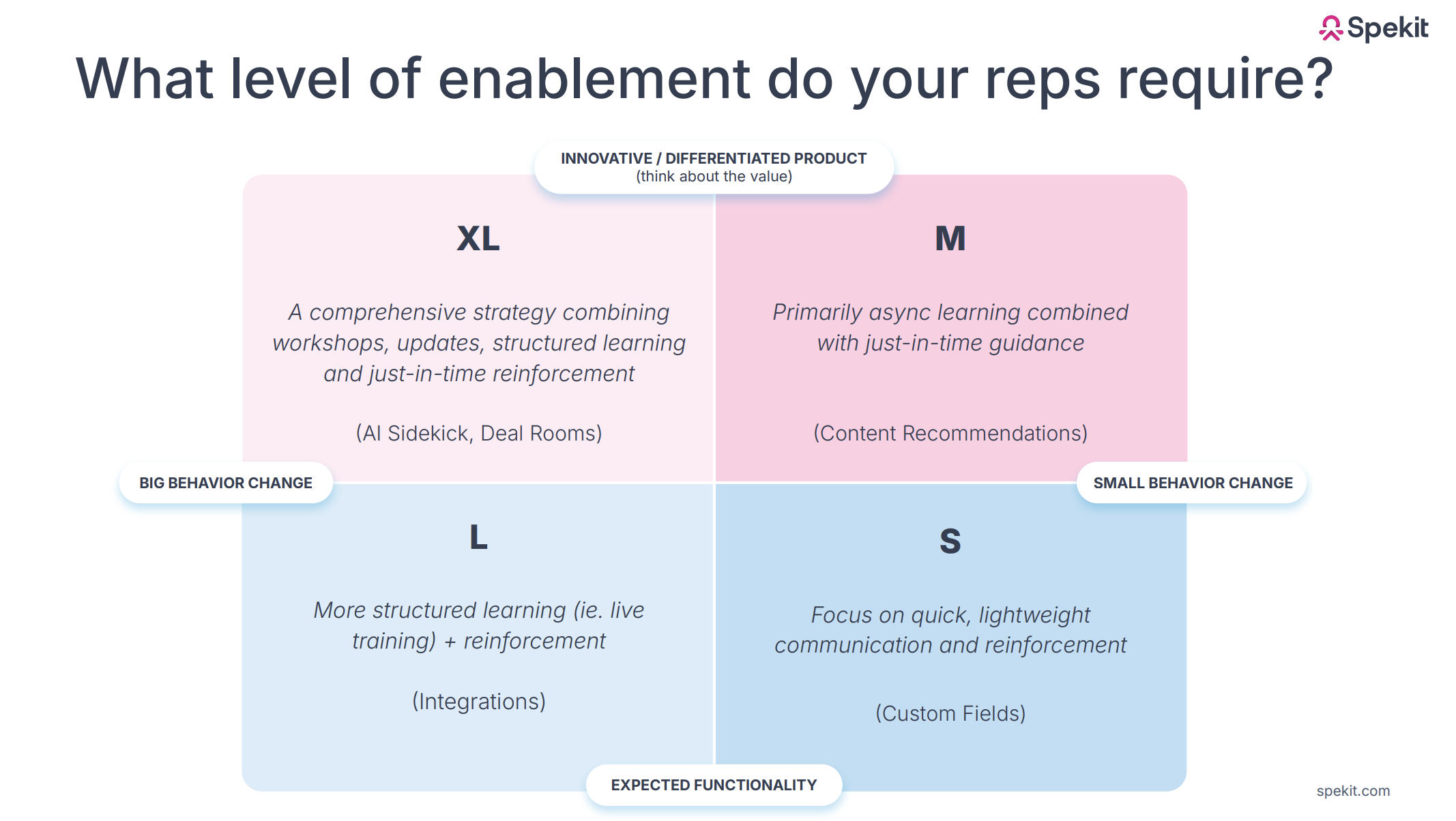
Field Notes: Where AI Actually Saves Time
This is where teams win hours back without cutting corners.
- Brief → messaging: The product brief lands in a trained template. PMM gets a crisp draft fast.
- Tickets → release notes: Jira tickets + the brief generate technical notes for Support.
- Learning → selling: The same deck gets cloned into Google Slides, then into a deal room, then surfaced at the point of need = no scavenger hunt.
Also: a huge reason to reinforce post-launch is content decay and mismatch. Up to 70% of sales content needs refresh, and 40% of content created by marketing goes unused, exactly why just-in-time recommendations and usage analytics matter.
------
Want the hard data behind what’s broken in sales and product marketing enablement and how leading teams are fixing it?
The 2025 Impact of Enablement report is packed with real-world examples, expert insights, and eye-opening stats from 100+ enablement leaders. Learn what’s behind:
- 80% of enablement and marketing content going unused
- 40% of sales enablement platform features collecting dust
- Why just-in-time enablement is gaining traction in AI-forward orgs
✅ Produced with the Sales Enablement Collective
✅ Featuring leaders from ZoomInfo, Medallia, Juniper, and dozens more
What This Looks Like in the Flow of Work
Make it real. A seller wraps up a call in Gong. The assistive layer suggests the competitive one-pager to skim and the buyer asset to send. One click adds it to the deal room. Later, while writing a follow-up email, the system surfaces the new feature video that others are sharing and shows usage. The rep drops it in. If they missed training, they still act correctly because the right step shows up at the right time.
It works because upstream was tight: one brief, one messaging core, one playlist, one update cadence, one intelligent recommendation layer.
Common Traps This System Avoids
- Announce and forget. Weekly updates and spotlights keep the message alive without noise.
- Everything is Tier-1. Decoupled tiering protects the calendar and the team.
- Who owns this. RACI and the council make ownership boring.
- Great deck, where is it. Playlists, updated messaging, and content recommendations remove the search step.
Copy-Paste Checklist You Can Run This Week
- Kickoff doc before kickoff. One-pager product brief with why, scope, beta vs GA, and success metrics.
- Two tracks, one plan. External tier plus enablement size in the kickoff.
- RACI plus runway. Owners across Product, PMM, Enablement, Ops, Analytics.
- Playlist the launch. Overview, 3-minute demo, messaging one-pager, persona notes, objections, competitive, buyer deck.
- Set the comms cadence. Weekly product update; spotlight only for high-impact moments.
- Reinforce in the flow. Just-in-time content, coaching, answers, and recommendations in CRM and email; micro checks two-to-five days after training.
- Instrument leading indicators. Track internal views, shares, playlist completion, buyer engagement, and feature fields in CRM. (Most teams believe reps use <60% of content! Measure what’s actually used).
Our Take: Why This Works
Most enablement playbooks were built for a slower era. Big quarterly releases. Long workshops. Heavy certifications. That model struggles when products and markets move weekly. This system meets three truths.
- Attention is scarce. Move the content to the seller, not the seller to the content.
- Message discipline wins. Centralized messaging flows everywhere, so the story stays tight.
- Speed matters. AI turns the brief into drafts and the backlog into notes so humans can coach and sell.
When you combine clear roles, a steady council, decoupled tiering, and just-in-time enablement reinforcement, launches stop being events and start becoming momentum.
Get the templates, playbooks, and key takeaways covered in the webinar - FREE
We pulled everything from the webinar into one interactive resource so you can steal our playbook and start planning your next launch today.
Here’s what’s inside:
- A step-by-step AI-powered product launch planning template
- A recap of key takeaways from the session (speed, RACI, reinforcement, and more)
- On-demand access to the full webinar
- Real examples from how we plan launches at Spekit
Whether you missed the webinar or just want to hit replay, this is your one-stop-shop for building smarter, faster, more aligned launches.
👉 Access the template and webinar recap now
